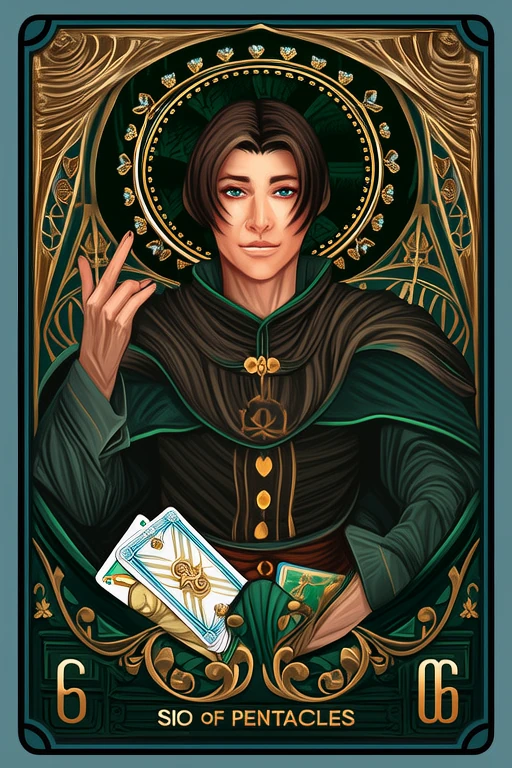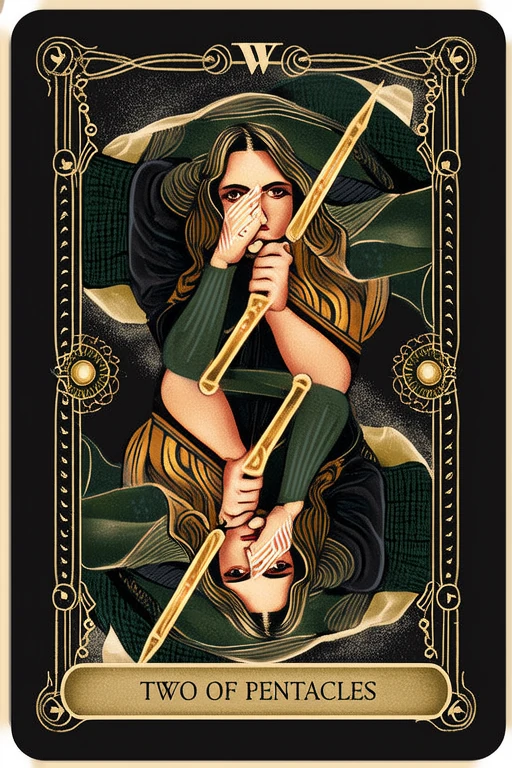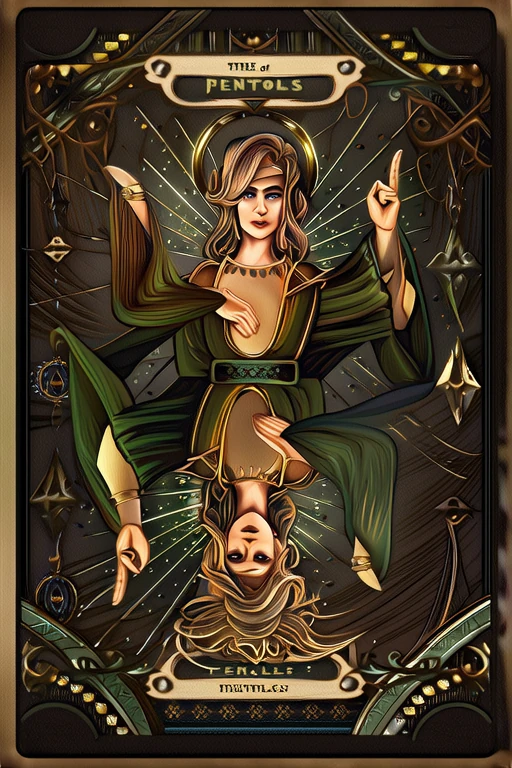
Six of Pentacles
Discover the deep meaning of Six of Pentacles with our free AI-powered tarot interpretation. Get instant, accurate readings based on advanced tarot knowledge.

Keywords
Upright Meaning
Charity, generosity, sharing
Reversed Meaning
Strings attached, stinginess, power and domination
Full Interpretation
The Six of Pentacles represents charity, generosity, and sharing your abundance.
In-Depth Analysis
📜 Historical Background
The Six of Pentacles is a Minor Arcana card from the suit of Pentacles (also known as Coins, Disks, or Earth in various tarot traditions). Its origins trace back to the earliest tarot decks of 15th-century Europe, particularly the Visconti-Sforza and Marseille decks, which laid the foundation for modern tarot symbolism and structure. In these early decks, the card was often depicted as a wealthy man distributing coins to two beggars, symbolizing generosity, charity, and the balance of material wealth. This imagery reflects the medieval European values of almsgiving and social responsibility, rooted in Christian teachings and feudal societal structures.
The card’s iconography has evolved significantly over time. In the classic Marseille design, the Six of Pentacles typically shows a standing figure holding a balance scale in one hand and six coins in the other, with two additional coins resting nearby. This imagery emphasized the themes of fairness, distribution, and economic justice. As tarot evolved into the esoteric and mystical realm in the 19th and 20th centuries—particularly with the rise of the Hermetic Order of the Golden Dawn and the Rider-Waite-Smith deck—the symbolism became more narrative and emotionally expressive. In A.E. Waite’s Rider-Waite-Smith version, illustrated by Pamela Colman Smith, a well-dressed man hands coins to two poorer individuals, with three coins hanging from a balance in his hand. This version emphasized the cyclical nature of giving and receiving, and the importance of financial equity.
Culturally, the Six of Pentacles has been interpreted through various lenses, including Christian charity, economic justice, and social responsibility. In some interpretations, it has been linked to the biblical parable of the talents (Matthew 25:14–30), which discusses the responsible use of resources. In other traditions, particularly in modern psychological tarot readings, it represents the balance of giving and receiving in interpersonal relationships, not just financially but emotionally as well.
Across different tarot decks, the Six of Pentacles retains its core theme of generosity and resource sharing, though the artistic interpretations vary. The Thoth Tarot by Aleister Crowley and Lady Frieda Harris renames it “Success,” focusing on the outcome of balanced exchanges and the rewards of fair dealings. The Shadowscapes Tarot depicts the card with a more mystical and nature-oriented approach, showing a figure offering coins to woodland creatures, symbolizing the sharing of abundance with the natural world.
The Six of Pentacles remains a powerful symbol of financial equity, social responsibility, and the cyclical nature of giving and receiving. Its evolution through history reflects changing societal values around wealth, charity, and mutual support, making it a timeless and relevant card in both traditional and modern tarot practice.
Symbolism & Imagery
The Six of Pentacles is rich in symbolic meaning, with each element of its imagery contributing to its deeper interpretation. At its core, the card represents the exchange of resources—whether financial, emotional, or spiritual—and the balance inherent in giving and receiving. In the Rider-Waite-Smith version, the central figure is a wealthy man dressed in fine clothing, standing upright and holding a balance in one hand while offering coins to two beggars. Behind him are six visible coins, with three in his hand and three resting on the balance. This visual symmetry emphasizes the idea of measured generosity and the fair distribution of wealth.
Each coin symbolizes material abundance and the tangible aspects of life—money, resources, and physical well-being. The balance in the figure’s hand represents justice, fairness, and the importance of maintaining equilibrium in financial or emotional exchanges. The two beggars signify those in need, highlighting the importance of charity, support, and social responsibility. The posture of the giver suggests confidence and control, indicating that the act of giving comes from a place of stability rather than obligation.
Color symbolism also plays a role in the interpretation of the Six of Pentacles. In many decks, the giver is depicted wearing green or gold clothing, colors traditionally associated with prosperity, growth, and wisdom. The beggars are often shown in muted or earth tones, representing humility and the need for assistance. The background of the card is typically serene, suggesting that the act of giving brings inner peace and harmony.
Numerologically, the number six is associated with balance, harmony, and responsibility. It reflects the idea of service to others and the nurturing of relationships. In tarot, the number six often represents the culmination of effort, as seen in the Lovers (VI) and the Tower (XVI), reinforcing the theme of balance and the consequences of actions.
Interpretively, the Six of Pentacles carries slightly different meanings depending on cultural and personal perspectives. In Western esoteric traditions, it is often linked to Christian charity and moral duty. In more modern psychological readings, it can signify the importance of reciprocity in relationships, the value of sharing knowledge or resources, and the need to maintain healthy boundaries in giving and receiving.
When upright, the Six of Pentacles typically indicates generosity, financial stability, and the fair distribution of resources. It suggests that the querent is in a position to offer support or may receive assistance from others. In a reversed position, the card can warn of imbalance—either giving too much without receiving in return or being overly dependent on others. It may also indicate misuse of resources, financial inequality, or a lack of reciprocity in relationships.
In relation to other cards in the deck, the Six of Pentacles follows the Five of Pentacles, which represents hardship and financial struggle, and precedes the Seven of Pentacles, which focuses on long-term investment and patience. Together, these cards form a narrative of overcoming scarcity, sharing resources, and planning for future stability. The Six of Pentacles thus serves as a bridge between struggle and abundance, reminding the querent of the importance of generosity, balance, and mutual support.
Psychological Insights
From a psychological perspective, the Six of Pentacles embodies themes of generosity, reciprocity, and the balance of power in relationships—both material and emotional. Carl Jung’s theory of archetypes offers a compelling lens through which to interpret this card. The Six of Pentacles aligns with the archetype of the Altruist or the Philanthropist, representing the human drive to give, support, and uplift others. This archetype also touches upon the shadow aspect of dependency, where the giver may unconsciously seek validation through their generosity, or the receiver may struggle with self-worth and reliance on external support.
In modern life, the Six of Pentacles serves as a reminder of the importance of financial and emotional equilibrium. It encourages individuals to examine their relationship with resources—whether money, time, or attention—and to consider how they give and receive within their personal and professional interactions. In decision-making, this card often appears when a person is at a crossroads involving charity, investment, or shared responsibilities. It advises a balanced approach, ensuring that generosity does not lead to depletion and that receiving is done with gratitude and awareness.
For personal growth and self-awareness, the Six of Pentacles prompts reflection on one’s role as both a giver and a receiver. It challenges individuals to assess whether they are maintaining healthy boundaries in their relationships and whether they are allowing themselves to accept help when needed. This card is particularly relevant for those in caregiving roles, reminding them to practice self-care and avoid burnout by recognizing the importance of mutual support.
In therapeutic and counseling contexts, the Six of Pentacles can be a valuable tool for exploring issues of self-worth, financial anxiety, and codependency. It helps clients understand the dynamics of giving and receiving in relationships, and encourages them to cultivate a sense of balance and reciprocity. Therapists may use this card to guide discussions around financial planning, emotional boundaries, and the psychological impact of wealth and poverty.
In modern spiritual practices, the Six of Pentacles is often associated with abundance consciousness and the law of reciprocity. Many practitioners use this card in rituals focused on prosperity, gratitude, and energy exchange. It serves as a reminder that wealth and support often flow in cycles, and that generosity—whether in time, resources, or love—can create a positive feedback loop that enhances one’s spiritual and material well-being. The card also resonates with the idea of karmic balance, reinforcing the belief that acts of kindness and fairness contribute to long-term harmony in life.
Correspondences
The Six of Pentacles is associated with the element of Earth, reflecting its grounding energy and connection to material wealth, stability, and tangible resources. In astrology, it corresponds to the planet Mercury, which governs communication, intellect, and commerce. This planetary influence adds a layer of discernment and strategic thinking to the card, emphasizing the importance of wise financial decisions and clear exchanges in relationships.
Gemstones and crystals linked to the Six of Pentacles include citrine, known for attracting abundance and prosperity; jade, symbolizing harmony and balance; and pyrite, which enhances confidence and supports financial stability. These stones can be used in meditation or carried as talismans to align with the card’s energy. Essential oils such as patchouli, sandalwood, and frankincense are also associated with this card, as they promote grounding, clarity, and a sense of security.
Herbs connected to the Six of Pentacles include basil, which is used for prosperity spells; cinnamon, known for its warming and attracting properties; and bay leaf, often used in money-drawing rituals. These can be incorporated into sachets, incense, or candle magic to enhance the card’s themes of abundance and balance.
Seasonally, the Six of Pentacles resonates with late summer and early autumn, a time of harvest and preparation. This aligns with its message of reaping what has been sown and ensuring fair distribution of resources. Temporally, the card is often linked to midday, a time of clarity and productivity, reinforcing its themes of active engagement and responsible management.
In terms of chakra connections, the Six of Pentacles is closely tied to the Root Chakra (Muladhara), which governs survival, security, and material well-being. Balancing this chakra supports financial stability and a sense of groundedness. It also resonates with the Heart Chakra (Anahata), emphasizing the emotional aspect of giving and receiving with compassion.
Numerologically, the number six is associated with harmony, responsibility, and service. It reinforces the card’s message of balanced exchanges and the importance of nurturing both self and others.
❓ Frequently Asked Questions
The Six of Pentacles is a card that often raises questions due to its layered meanings around generosity, financial balance, and reciprocity. One of the most common questions is: 'Does the Six of Pentacles always indicate money?' While the card is strongly associated with financial matters—especially giving, receiving, and fair distribution—it can also symbolize emotional support, knowledge sharing, or spiritual guidance. It is not limited to literal money but rather represents the exchange of resources in any form.
Another frequently asked question is: 'What does the Six of Pentacles mean in love and relationships?' In a love reading, this card often suggests a balanced partnership where both individuals contribute equally. It may also indicate that one person is offering emotional or financial support to the other. However, if the card appears reversed, it can point to an imbalance—such as one partner giving too much or feeling taken advantage of.
Beginners often wonder, 'Is the Six of Pentacles always a positive card?' While it is generally seen as a favorable card, especially in financial readings, its meaning depends on context. Upright, it suggests generosity, stability, and fair dealings. Reversed, it can warn of financial dependency, imbalance, or unequal exchanges. Understanding the surrounding cards and the querent’s situation is essential for accurate interpretation.
Professional readers often use the Six of Pentacles in spreads related to financial decisions, career advice, or relationship dynamics. In a three-card spread, for example, it may appear as the present situation, indicating that the querent is currently in a phase of giving or receiving support. In a Celtic Cross spread, it might fall in the 'challenge' position, suggesting that the issue at hand involves an imbalance in resources or expectations.
How does the Six of Pentacles interact with other cards? When paired with the Two of Cups, it suggests a balanced and mutually supportive relationship. With the Five of Pentacles, it indicates a shift from hardship to stability, often through the help of others. However, when combined with the Devil, it may warn of financial or emotional dependency that is unhealthy or exploitative.
For practical interpretation, it’s important to consider the querent’s current life circumstances. If someone is facing financial hardship, the Six of Pentacles may indicate that assistance is on the way. If they are in a position of abundance, it may be a reminder to give back or maintain generosity without overextending. In all contexts, the Six of Pentacles encourages mindful, balanced exchanges and the recognition of interdependence in all aspects of life.



